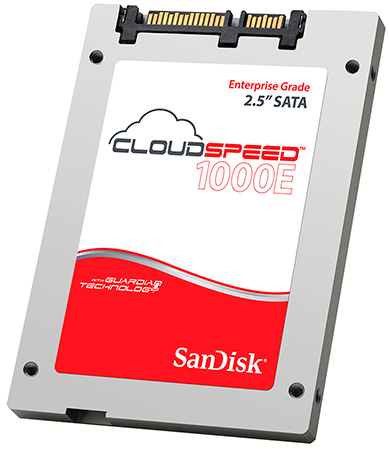SanDisk CloudSpeed 1000E Enterprise SSD Review
Introduction and specifications
If you’ve spent any time at all following PC and storage technologies, you probably know that SanDisk is a brand that is synonymous with Flash memory. Whether it’s a memory card for a digital camera or a high-performance solid state drive for an enthusiast-class PC, odds are SanDisk has got you covered. And even in the highly unlikely event that you’ve never heard of SanDisk, we’d bet you still own a gadget or other piece of electronics/tech that’s uses some sort of SanDisk Flash memory, the company’s products are that pervasive.
Though SanDisk’s technology is widely used in the consumer space, they’ve also got an array of products that target the enterprise, one of which we’ll be showing you here—the CloudSpeed 1000E enterprise grade 2.5” SSD. Somewhat surprisingly, this drive leverages Toshiba’s 19nm NAND Flash memory instead of SanDisk’s own Flash, but there’s a good reason for that. Take a look at the specs for the CloudSpeed 1000E (and CloudSpeed 1000) family of drives in the able below and then we’ll explain what makes the drive tick...
|

As you can see, SanDisk offers CloudSpeed drives with capacities ranging from 100GB all the way up to 960GB, depending on the family. The CloudSpeed 1000E (which is the drive we’ll be showing you here) has a much higher endurance rating, due in part to significant over-provisioning on the drive.
The SanDisk CloudSpeed 1000E conforms to the typical 2.5” form factor popular with most solid state drives, and features a 7mm Z-height. The drive also sports a sturdy, all metal enclosure that’s devoid of any plastics. The use of metal all around gives the drive some heft; it is clearly heavier and more rigid than most consumer-class solid state drives.
Inside the CloudSpeed 1000E’s enclosure lies a PCB adorned with Toshiba 19nm MLC Flash memory, a Marvell 9187 controller, and couple of pieces of Micron DRAM cache memory. The number of Toshiba NAND Flash packages will vary based on the drive’s capacity, but the particular model you see here—the 800GB CloudSpeed 1000E—has 16 pieces of NAND, 8 on the top of the PCB, 8 on the bottom. The total capacity of NAND on the PCB, however, adds up to 960GB. The 17% of unused of capacity is over provisioned for maintenance and other functions. This is probably a good time to point out that the CloudSpeed 1000E family of drives were originally brought to market by a company called Smart Storage, which focused on enterprise storage, and was acquired by SanDisk in the middle of last year. Hench the reason the drive isn’t packed with all SanDisk ICs.
On the bottom of the PCB, you’ll also see two arrays of capacitors at either end. The CloudSpeed 1000E features backup-power circuitry to ensure the drive can flush its cache and complete any write operations in the event of a power outage. In addition to its backup-power features, which are designed to improve reliability and data integrity, the CloudSpeed also features some proprietary technologies that improve endurance. SanDisk calls those features the “Guardian Technology Platform”, and according to the company they allow the CloudSpeed 1000E to offer 5x the endurance than some other MLC-based solid state drives. If you look at the specs again, you’ll see this drive is rated for 3 – 7 drive writes per day, which is many, many times higher than a consumer-class drive, some of which are rated for only rated for 20GB/day host writes. The CloudSpeed 1000E also offers an MTBF of 2 million hours, and an uncorrectable bit error rate (UBER) of less than 1 in 1018 bits read, which is an 100x improvement over the JEDEC JESD 218 spec for enterprise grade SSDs.
Clearly this is a drive designed for high reliability and long endurance, but its performance turned out to be competitive as well.









